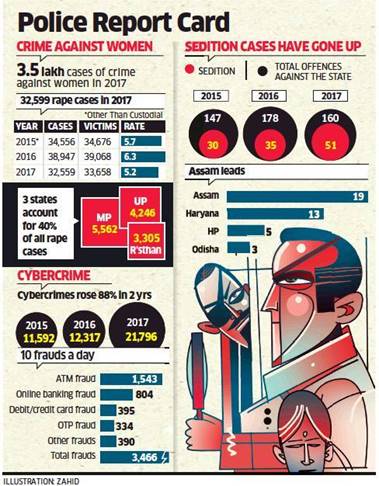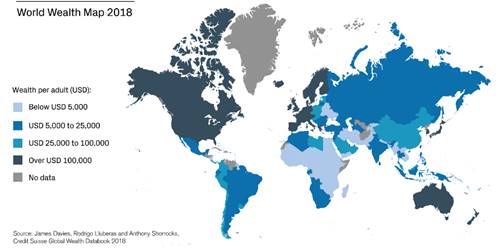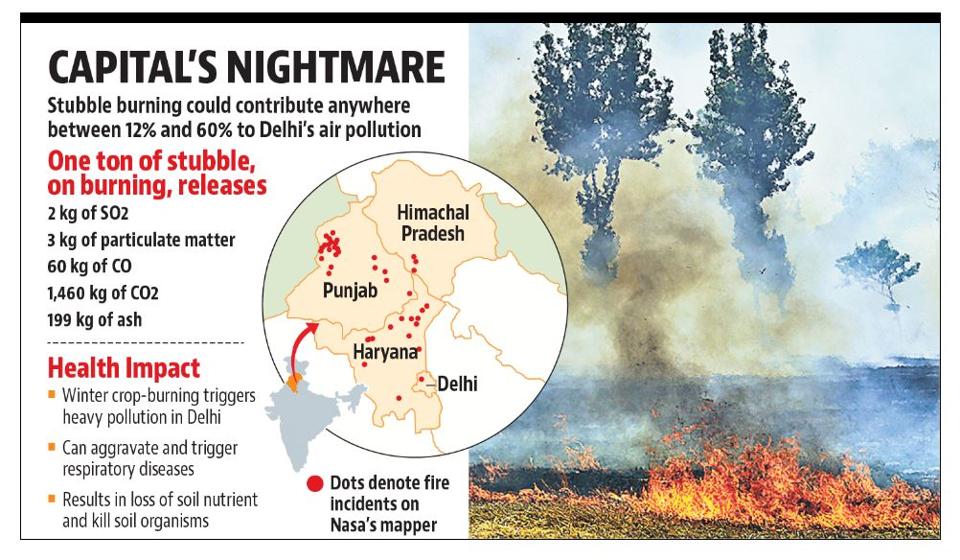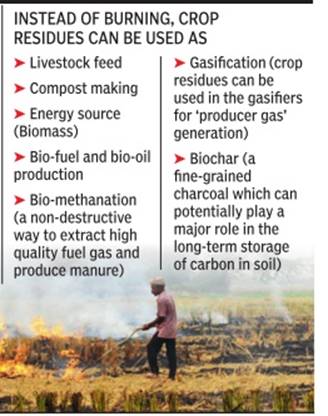DAILY NEWS ANALYSIS 23 OCTOBER
SECURITY
SC to hear all cases seeking social media data access for Govt. agencies
Supreme Court transferred to itself all petitions seeking to make social media platforms such as Facebook and WhatsApp more accountable in fighting crime and terror by allowing agencies access to encrypted data, even as the Centre stated that it does not want to invade privacy of citizens.
Government Argument:
- Government do not want to invade privacy, but no intermediary can say their platform is so secure that it cannot be used for crime (or) terrorism.
- If information is required to protect sovereignty of the country and is in national interest, it has to be provided.
- A balance has to be struck between national interest, sovereignty, police investigation and individual privacy.
- Intermediaries are using country’s resources to establish their system and they refuse to facilitate decryption.
- Drugs, weapons and other contraband can be sold through the use of platforms run by the intermediaries.
- There are various messages and content spread/shared on the social media, some of which are harmful.
- Section 69 of Information Technology Act, 2000, mandated the authorities to lawfully intercept any information transmitted through any computer resource if authorities are “satisfied that it is necessary or expedient so to do in the interest of sovereignty or integrity of India, security of the State”.
Court Arguments:
- Even in the US, Government are sending information to outside agency to decrypt the information.
- De-encryption, if available easily, could defeat the fundamental right of privacy and de-encryption of messages may be done under special circumstances but it must be ensured that the privacy of an individual is not invaded.
- The sovereignty of the state and the dignity and reputation of an individual are required to be protected
Petitioner’s arguments:
- The matter should be decided in view of privacy ruling in Aadhaar case.
- WhatsApp, on the other hand, has submitted that it is impossible for it to trace the creator of the “questionable content” since it has end-to-end encryption.
NCRB data: Cyber crime jumped by 77% in 2017
The number of cyber crimes increased dramatically in 2017 as compared to 2016, and nearly every fifth cyber crime in 2017 was committed against a woman, official data for that year released by the National Crime Records Bureau (NCRB) show.
In absolute numbers, UP, the most populous state, registered the largest number of cyber crimes (4,971), followed by Maharashtra (3,604), and Karnataka (3,174).
Crimes against children included Internet crimes committed through online games, etc. This is the first time that NCRB has compiled data on the nature of cyber crimes against women and children.

Steps for preventing Cyber Crime:
- Establishment of National Critical Information Infrastructure Protection Centre (NCIIPC) for protection of critical information infrastructure in the country.
- All organizations providing digital services have been mandated to report cyber security incidents to CERT-In expeditiously.
- Cyber Swachhta Kendra (Botnet Cleaning and Malware Analysis Centre) has been launched for providing detection of malicious programmes and free tools to remove such programmes.
- Issue of alerts and advisories regarding cyber threats and counter-measures by CERT-In.
- Issue of guidelines for Chief Information Security Officers (CISOs) regarding their key roles and responsibilities for securing applications / infrastructure and compliance.
- Provision for audit of the government websites and applications prior to their hosting and thereafter at regular intervals.
- Empanelment of security auditing organisations to support and audit implementation of Information Security Best Practices.
- Formulation of Crisis Management Plan for countering cyber attacks and cyber terrorism.
- Conducting cyber security mock drills and exercises regularly to enable assessment of cyber security posture and preparedness of organizations in Government and critical sectors.
- Conducting regular training programmes for network / system administrators and Chief Information Security Officers (CISOs) of Government and critical sector organisations regarding securing the IT infrastructure and mitigating cyber attacks.

Reference: https://indianexpress.com/article/explained/ncrb-data-cyber-crime-jumped-by-77-in-2017-6082779/
SOCIETY
NCRB data: Insults made up 50% of crimes against Dalits, ‘traps’ of corrupt officials spiked
More than half of all offences registered under the Scheduled Castes and the Scheduled Tribes (Prevention of Atrocities) Act where victims were Dalits, were related to insult and humiliation heaped on them, data from 2017 released by the National Crime Records Bureau (NCRB) show.
Crimes against Dalits:
- NCRB has for the first time published data for cases in which only the SC/ST Act was invoked without any sections of IPC.
- Unlike the 2016 data, there are separate figures for 2017 for intentional insult or humiliation of a Dalit, occupation of Dalit land, preventing the use of public space, and social boycott.
- 55% cases were related to “Intentionally Insult or Intimidate with Intent to Humiliate”.
- There were 47 cases of land grabbing related to Dalits.
- They faced social boycott in 63 cases.
- They were prevented from using public spaces in 12 cases.
- Countrywide, 43,203 cases of atrocities against Dalits (including IPC and SC/ST Act cases) were reported in 2017, about 6% more than in the previous year.
- Higher numbers for crimes against Dalits also reflect more robust reporting of crimes by victims, which indicates empowerment.
Crimes against Tribals:
- 52% pertained to “Intentionally Insult or Intimidate with Intent to Humiliate”.
- There were 27 cases of land grabbing related to tribals.
- 18 cases of tribals facing social boycott.
- The 7,125 cases of atrocities against tribals (including IPC and SC/ST Act cases) in 2017 were about 9% more than in 2016.
Cases of Corruption:
- Registration of corruption cases has fallen by over 20% since 2015.
- “Trap” cases have spiked, while cases of criminal misconduct have fallen sharply since 2016.
- “Trap” cases, in which bribery is caught red-handed, generally involve lower-level officials who accept gratification in cash.
- Criminal misconduct cases generally involve higher officials; pecuniary gains in these case are rarely made in cash.
- This could mean either reduced corruption at higher levels, or increased enthusiasm among law enforcement to go after small offenders.
About NCRB:
- The National Crime Records Bureau, abbreviated to NCRB, is an Indian government agency responsible for collecting and analysing crime data as defined by the Indian Penal Code (IPC) and Special and Local Laws (SLL)
- NCRB is headquartered in New Delhi and is part of the Ministry of Home Affairs (MHA), Government of India.
- NCRB was set-up in 1986 to function as a repository of information on crime and criminals so as to assist the investigators in linking crime to the perpetrators.
Objectives of NCRB:
- Create and maintain secure sharable National Databases on crimes and criminals for law enforcement agencies and promote their use for public service delivery.
- Collect and process crime statistics at the national level and clearing house of information on crime and criminals both at National and International levels.
- Lead and coordinate development of IT applications and create an enabling IT environment for Police organizations.
- National repository of fingerprints of all criminals.
- To evaluate, modernize and promote automation in State Crime Records Bureaux and State Finger Print Bureaux .
- Training and capacity building in Police Forces in Information Technology and Finger Print Science

ECONOMY
Explained: What determines the wealth of a nation
The Credit Suisse Group, a Switzerland-based multinational investment bank, has released the 10th edition of its annual Global Wealth Report.
The report typically tracks both the growth and distribution of wealth – in terms of the numbers of millionaires and billionaires and the proportion of wealth that they hold – as well as the status of inequality around the world.
Report Findings:
- China has overtaken the United States this year to become “the country with most people in the top 10% of global wealth distribution”.
- Just 47 million people – accounting for merely 0.9% of the world’s adult population – owned $158.3 trillion, which is almost 44% of the world’s total wealth.
- At the other end of the spectrum are 2.88 billion people – accounting for almost 57% of the world’s adult population – who owned just $6.3 trillion or 1.8% of the world’s wealth.
- The bottom half of wealth holders collectively accounted for less than 1% of total global wealth in mid-2019, while the richest 10% own 82% of global wealth and the top 1% alone own 45%.
- The global financial crisis of 2008-09 seems to decidedly hurt those at the bottom of the pyramid more than the wealthiest as inequalities within countries grew in the wake of the GFC.
Definition of Wealth:
- Wealth is defined in terms of “net worth” of an individual. This, in turn, is calculated by adding up the value of financial assets (such as money) and real assets (such as houses) and then subtracting any debts an individual may have.
Drivers of the Wealth of Nation:
- Overall size of population is one possible factor that drives wealth per adult in the country.
- Another important factor is the country’s saving behaviour. A higher savings rate translates into higher wealth. Overall, a percentage point rise in the savings rate raises the growth rate of wealth per adult by 0.13% each year on average.
- Most important factor in determining the different trends in household wealth among countries is general level of economic activity as represented by aggregate income, aggregate consumption or GDP.
- That’s because the expansion of economic activity increases savings and investment by households and businesses, and raises the value of household-owned assets, both financial and non-financial.
- In the longer term, the most successful countries are those that succeed in raising wealth as a multiple of Gross Domestic Product (GDP) by addressing institutional and financial-sector deficiencies.
ENVIRONMENT
Rise in stubble burning cases in Punjab
As paddy harvesting hasgathered momentum in Punjab, the key grain producingState, as many as 3,307 casesof stubble fibre incidents havebeen reported till October21, as against 2,564 incidentsin the corresponding periodlast year.
Reasons behind rise of stubble burning:
- Decision to advance the date of paddy sowing this season, a week earlier than the scheduled date of June 20.
- Consequently, harvesting ofthe crop has also started early this time.
- Even though farmers are aware that the burning of straw is harmful to health, they do not have alternatives for utilising them effectively.
- Experts say that with less income due to crop damage, farmers are likely to be inclined to light up their fields to cut costs and not spend on scientific ways of stubble management.
- It costs Rs 1,500-3,000 per acre for stubble management, depending on the equipment and method.

Steps taken to curtail stubble burning:
- Provision of subsidised agro machines andequipment to farmers andcooperative societies.
- The State government has so far not issuedany ‘challaan’ to those farmers who have been defyingthe ban on stubble burning.
- The ban and action againstpeople burning crop residueis regulated under the Air(Prevention and Control ofPollution) Act, 1981.
Impact of the steps:
- Last year, the burntarea had decreased by 9.95%in comparison to 2017.
Further Steps:
- Compensate farmers for not burningpaddy straw.
- The available paddy straw can be effectively used for power generation.
- Incorporation of crop residues in the soil can improve soil moisture and help activate the growth of soil microorganisms for better plant growth.
- The 2014 national policy envisages adoption of technical measures, including diversified uses of crop residue, capacity building and training along with formulation of suitable legislation, to deal with the issue of disposing of stubble.

Source: The Hindu



1.png)
